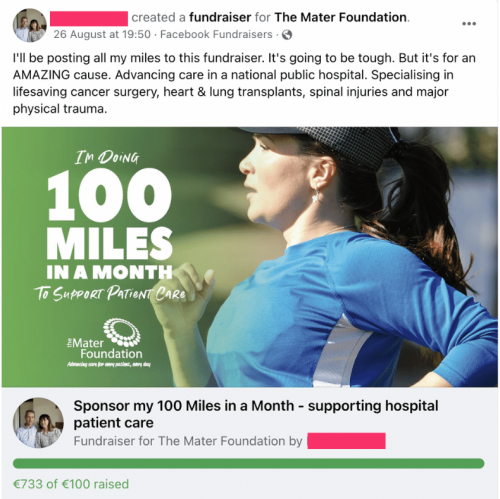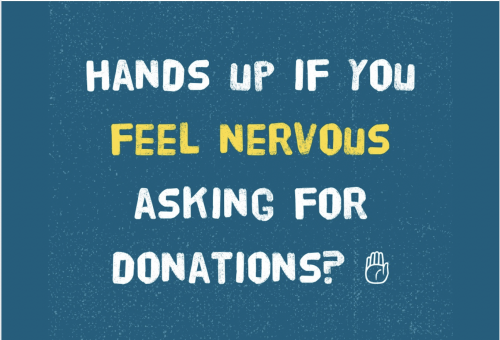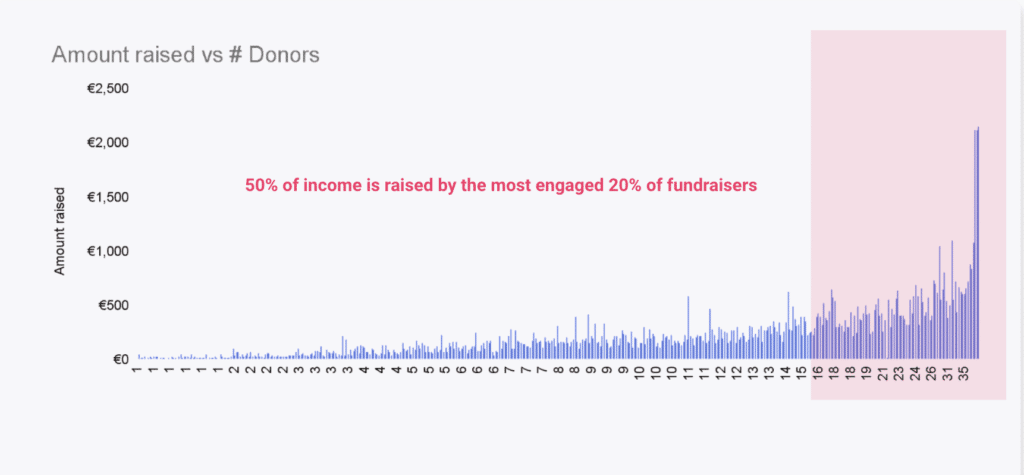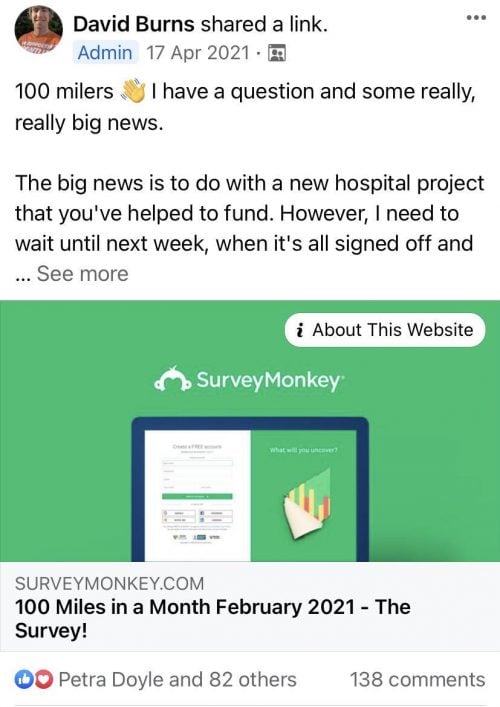Blog 10 reasons why your Facebook Challenge isn't performing (and how to fix it)

10 reasons why your Facebook Challenge isn't performing (and how to fix it)
Picture this: you’ve set up your Facebook Challenge, you have supporters in your Facebook Group and you’re sending out the incentives. But the worst has happened… people aren’t fundraising.
It’s the stuff of nightmares for many nonprofits, but 9 times out of 10 there’s a simple reason why your supporters aren’t taking the action you need them to. If you know why your Facebook Challenge is struggling, you can solve the problem before it’s too late!
Here are 10 reasons why your Facebook Challenge isn’t performing, and what you can do to fix it.
1. You’re not fixating on your cost-per-active fundraiser
Let’s get one thing clear: not fixating on cost-per-active fundraiser is ruining your Facebook Challenge. If you don’t focus on this metric, you will be misled by other ones – without fail. This measurement is the best criterion for judging your Challenge ads (just as long as you’re not making any other major mistakes on this list!)
To truly assess your ad performance, take your total media spend and divide it firstly by the total number of fundraisers and then by the total number of fundraisers with at least 1 donation (depending on how up-to-date your income reporting is). Then ask yourself how many fundraisers will be recruited at that cost, with the media budget you have available.

If you discover your cost-per-active fundraiser is too high, here are a few steps to take. You can also check out our best practice guidance for Facebook Challenge ad creatives for more advice and tips.
- Rule out other factors: Test your calls-to-action to make sure they’re clear and the links work.
- Put in place some of the creative corrections outlined in section 3 above: This will depend on your results. Remember that raising the age targeting and removing Instagram as a placement helps to refine your audience.
- Review the ads in terms of what is likely to bring in the best combination of quality and quantity: Are there any ads bringing in a better quality of lead? Use a VLOOKUP to compare leads to fundraisers to be really sure.
- Move budget: Put more budget where you think there’s better lead quality. Or better yet, make sure each Ad Set has a decent budget (more than they need) but with bid caps and Campaign Spending Limit to stop them getting out of control. You can usually adjust bid caps without resetting the learning phase, as long as they are in from the beginning. You can also switch off the Ad Sets which aren’t performing, and then the others will automatically have more to spend before the Campaign Spending Limit is reached.
- Start afresh: Duplicate the best quality ads into new Ad Sets with their own budget (or new Campaigns if you have Campaign Budget Optimization on). Also keep it fresh by adding in new creative based on lessons learned.
2. You’re not segmenting your supporter communications
Not segmenting your supporter communications is another big mistake. Facebook Challenges are a fundraising funnel, so you’ll have people who’ve clicked on your ads, people who have clicked into your Challenge Group, people who have registered, and people who are actually fundraising.
Sending blanket emails to every supporter with every step is a no-no. Instead, make sure you’re timely, relevant and targeted in all your Challenge communications.

For example, you can email sign-ups from your ads prompting them to join your Group, then welcome and tag all new members of the Group reminding them to register. Additionally, you can send an SMS to everyone who has registered, with a reminder to activate or share their fundraiser.
Check out our top tips for running a successful supporter journey alongside your Facebook Fundraising campaign.
3. You’re not optimizing your Custom Fundraisers
Custom Facebook Fundraisers are an incredibly useful tool if used correctly! But you have to step into the shoes of your supporters’ supporters to optimize them.
I often see participants with fundraisers in the following format:
- Title: 100 Miles in a Month for Charity Name
- Cover Photo: Graphic repeating 100 Miles in a Month for Charity Name.
- Description: I’m doing 100 Miles in a Month for Charity Name.
So, what would an optimized fundraiser look like instead?
- Title: Support my 100 Miles in a Month – Charity Name
- Cover Photo: Photo evoking activity, stating All Donations Welcome!
- Description: I’d love your support. This is a really tough, personal challenge.
It might not seem like much, but now the Custom Fundraiser is an aid to the person who activated it. It’s helping them to make a personalized ask to their network straight away!

4. You’re not testing your user journey
This one is a doozy and it can ruin any appeal, including your Facebook Challenge. So how do you test your journey?
Facebook Ads Manager allows you to preview and sign-up to your own lead ads. Take advantage of this feature! All you need to do is click 'sign-up' and provide your personal email address.

Now you’re a user! Read the first two emails from that end user’s point of view. What would stop you from binning them? Even better, get a friend to do this test journey as well, and click on every link to be sure it works.
5. You’re not planning your logistics
Your Challenge participants need to know when to expect their starter pack. That’s why they’re always asking! When you get anything online now, you receive a confirmation email with the date of arrival, so that’s the user standard.
To communicate shipping in the same way, just use the GivePanel confirmation email attached to your form. Write in the anticipated pack dispatch date, and update that text as necessary during recruitment.
Keep your eyes peeled for GivePanel SMS which is coming soon. Research from our Australian partners shows that texting users with this info helps establish reciprocity and boost fundraising!
6. You’re not motivating the Group
An unmotivated Facebook Group is very unlikely to fundraise, no matter how many times you ask them or whether you send lots of lovely emails and texts. Successful Facebook Challenges depend on a vibrant community. Check out our tips to engage your Facebook Group and get them fundraising.
If your posting style isn’t working, don’t persist! Just change tack. If a fundraising infographic fails, then try a short question such as “is anyone having trouble fundraising?” Follow this up by answering all of the comments at length.

7. You’re not telling stories
People sign up to Facebook Challenges to change their daily routine and transform their lives in some small way. Storytelling helps to fan that spark into a fundraising fire.
A good story needs a hero, some adversity, and an arc of transformative change. It should be told in the first person and accompanied by a photo of the teller.
If you can’t interview your beneficiaries, you might try and get a moving story from a past participant. Stories keep fundraisers motivated to continue, and inspire them to contribute to more change.
Read more about the importance of storytelling in peer-to-peer social fundraising.
8. You’re not reviewing your best fundraisers
For many Facebook Challenges, 20% of the fundraisers are responsible for 50% of the total funds raised. But who makes up that amazing 20%?

Well, this is where GivePanel really helps! Start with where they’re located, which will come from your registration data. You can also go to their fundraising pages from GivePanel, and by extension their Facebook profile. Survey a representative sample – 20% of that top 20%. Learning more about your best fundraisers should help you build campaigns that better appeal to them.
9. You’re not understanding your worst fundraisers
When people join Facebook Challenges and do not raise any donations on their fundraisers, they become a net cost. That cost comes from many areas, including advertising, event support, communications and materials.
That is why it’s so important to also understand these fundraisers better.
Here’s a simple methodology for you:
- Filter all your $0 fundraisers from the GivePanel Fundraiser Table.
- Calculate the size of a 20% sample.
- Investigate which ads appealed to that sample using UTM codes or VLOOKUP.
- Click into the sample’s Facebook fundraising pages and their profiles by extension.
- Review their registration data.
Build a persona for the people who do not raise funds, in the same manner that you would for your best fundraisers. That way you can use it to avoid – or better assist – this audience.
10. You’re not focusing on lifetime value
I’ve raised money on Twitch, Instagram, and Facebook, but I have never been stewarded beyond the initial event. Not focusing on lifetime value is ruining the potential of your Facebook Challenges.
During your Facebook Challenge, you’re sharing your mission and your impact stories with thousands of new supporters for 6 to 8 weeks. At the end of the Challenge, you just need to include one simple question in a short survey.
“From what you’ve learned during the Challenge, would you be open to supporting our charity in the future?”
Then you can set a very low barrier to entry as a regular giver, and set a reminder to increase the ask at a future date, once they’ve seen more concrete impact stories.

Book a GivePanel Demo
Book your 30 minute demo with one of our awesome Facebook Fundraising specialists today to see if GivePanel could help you supercharge your Facebook fundraising.
Related Resources
- How to plan the perfect Facebook Fundraising Challenge in 2022
- Quiz: is your nonprofit the right fit for a Facebook Challenge?
- The importance of storytelling in peer-to-peer fundraising
- Is optimizing Facebook Ads for lowest cost per lead giving you the best fundraisers?
- 5 secrets of hyper-engaged social communities (with results!)





